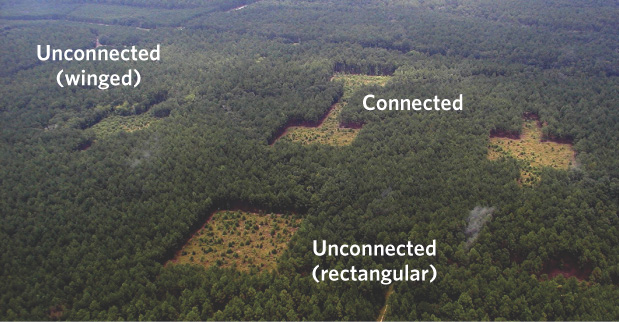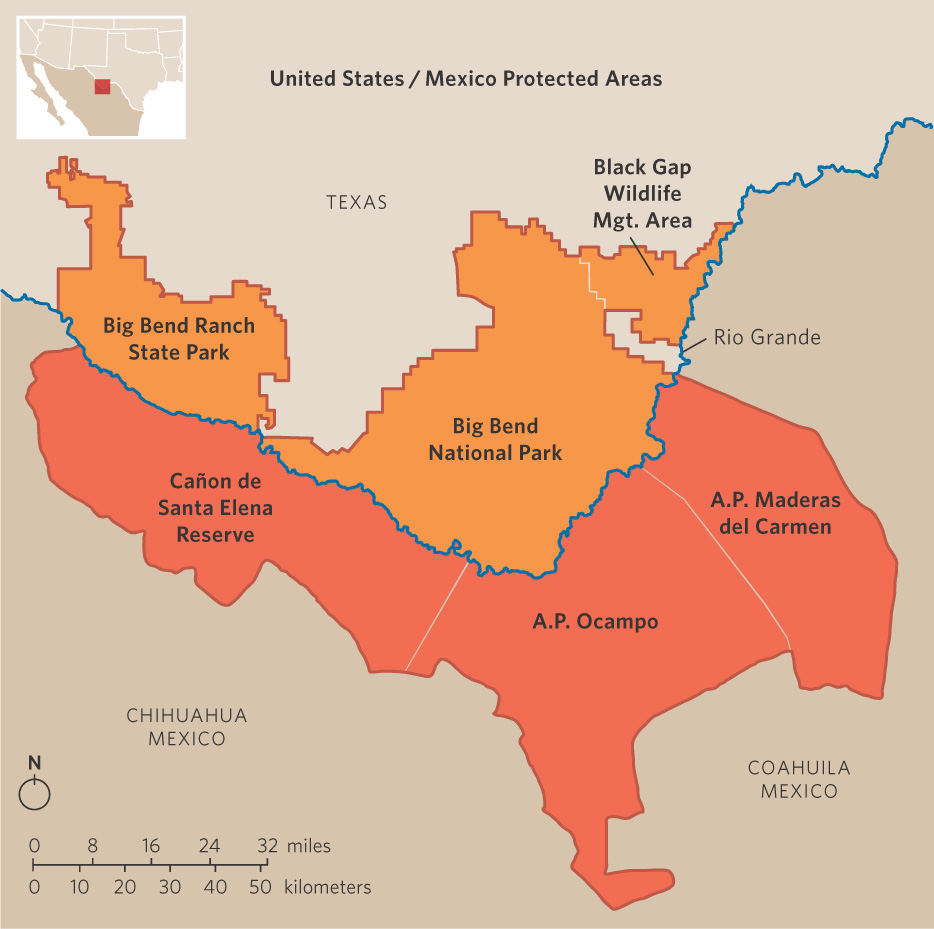Dispersal is essential to colonizing new areas
As we mentioned earlier in this chapter, dispersal plays a key role in allowing individuals to move between patches of habitat and to colonize suitable habitats that are not inhabited. In this section, we will discuss how suitable habitats may remain unoccupied due to dispersal limitation; we will also examine how habitat corridors can play an important role in facilitating dispersal.
Dispersal Limitation
Dispersal limitation The absence of a population from suitable habitat because of barriers to dispersal.
In some cases, as we saw with the Chinese bushclover, not enough time has passed since the introduction of a species for individuals to spread to every suitable habitat. In other cases, such as the collared lizards, there are substantial barriers that prevent dispersal. A common barrier to dispersal is the presence of large expanses of inhospitable habitat that an organism cannot cross, such as an ocean that a plant seed cannot cross or a large desert that an amphibian cannot cross. Recall that the sugar maple has a preferred range of temperatures and precipitation that favors its presence in the northern temperate forests of North America. Although there are no other suitable areas for sugar maples to grow in North America, there is an abundance of suitable habitat in Europe and Asia. Indeed, several other species of the maple genus (Acer) live in habitats that should be suitable for the sugar maple. Sugar maple does not exist in Europe and Asia because its seeds are not capable of dispersing from North America across the oceans to these distant regions. Sometimes the inhospitable habitat is not particularly expansive but still serves as an effective barrier to dispersal, as was the case with fire-suppressed forests that surrounded glades and prevented collared lizard dispersal. The absence of a population from suitable habitat because of barriers to dispersal is called dispersal limitation.
Occasionally, individuals cross formidable barriers and disperse long distances without assistance from humans. We know this because many species of plants and animals have populated remote islands, such as the Hawaiian Islands, before humans arrived. However, humans have affected the dispersal of many species. For example, human activities such as road building and forest clearing have created barriers to dispersal for some species. Humans have also assisted in the dispersal of plants and animals for thousands of years. For instance, aboriginal peoples brought dogs to Australia and Polynesians distributed pigs and rats throughout the small islands of the Pacific. In more recent times, foresters have transplanted fast-growing eucalyptus trees from Australia and pines from California to points all over the world for timber and fuel wood. Other species have been intentionally moved to assist them in dispersing over barriers created by humans, such as roads. Still other species have been accidentally moved over large distances by riding along in the ballast water of cargo ships or by attaching themselves to the outside of ship hulls. In most cases, individuals are introduced into a new area but never establish a viable population. In some cases, however, the introduced individuals are able to develop into a population that can grow and expand its geographic range over time. We’ll have much more to say about such invasive organisms later in this book, but their success in many places outside their native ranges emphasizes the role of barriers to dispersal in limiting species’ distributions.
Habitat Corridors
Habitat corridor A strip of favorable habitat located between two large patches of habitat that facilitates dispersal.
In some landscapes, dispersal is facilitated by narrow strips of favorable habitat known as habitat corridors that are located between large patches of habitat. For example, two forests might be separated by an open field with a stream that has a narrow band of trees along its banks. This narrow band of trees along the stream can serve as a corridor of suitable habitat between the forests and allow individuals to easily disperse between them.
In recent years, ecologists have conducted large manipulative experiments to test the importance of habitat corridors. For example, in the pine forests of South Carolina, storms and fires often create cleared areas that are suitable habitat for many species of understory plants and animals. To test the importance of habitat corridors in facilitating dispersal between these cleared areas, researchers cleared large (1.375 ha) patches of forest. Using a group of five cleared areas, the central cleared area served as the source of dispersers in the experiment. Of the remaining four patches, one was connected to the central patch with a cleared path that could serve as a corridor. The other three outer patches included a simple rectangular-shaped patch and two patches with “wings,” meaning that they were patches with corridors that did not connect to other patches (Figure 11.13). The researchers replicated this experimental design eight times.

262
The researchers used a number of methods for measuring dispersal. They followed movements of the common buckeye butterfly (Junonia coenia) by marking individuals in the central patch and recaptured them in the four outer patches. To track pollen movement, the investigators planted eight male winterberry plants (Ilex verticillata) in each central patch and then planted three mature female plants in each of the four outer patches. Fertilized flowers producing fruits in the outer patches would indicate that pollen had moved from the central patch. To track seed and fruit movements, they planted individuals of a local holly (Ilex vomitoria) and wax myrtle (Myrica cerifera) in the central patch. In some cases, the fruits in the central patch were dusted with colored fluorescent powder. The researchers then collected samples of bird droppings in traps placed under artificial perches in each outer patch. Fecal matter that fluoresced under ultraviolet light indicated that birds had consumed fruits in the central patch and dispersed them to the outer patches.
The results of these experiments are shown in Figure 11.14. The outer patch connected by a habitat corridor had much more dispersal from the central patch. The researchers observed more dispersal by butterflies, more traffic by insect pollinators—which caused more fruits to be produced—and greater movement of fruits and seeds found in bird droppings. Indeed, the movement of fruits and seeds through the corridors was so frequent that the number of species of herbs and shrubs increased faster in the connected patches. Experiments such as these confirm the importance of habitat corridors. Indeed, conservation efforts have increasingly considered the preservation of corridor habitats. Along the Rio Grande in Texas, for example, state and federal biologists, in collaboration with conservation organizations, have pushed to protect river-side habitats that would allow species to move easily among large patches of protected land. As you can see in Figure 11.15, in the United States this land includes Big Bend National Park, Big Bend Ranch State Park, and the Black Gap Wildlife Management Area. Across the river in Mexico the protected lands include the Cañon de Santa Elena Flora and Fauna Protected Area, the Ocampo Flora and Fauna Protected Area, and the Maderas del Carmen Flora and Fauna Protected Area.


263